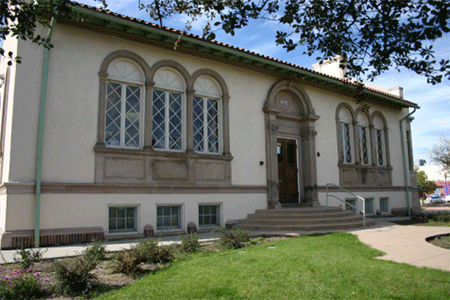
Overview
Renovation project included:
- Create much needed community spaces for meeting, learning and making
- Neighborhood needs experiential space to keep youth engaged and learning while not in school or work
- Repair, restore, maintain and protect this treasured 100-year Carnegie library
- Adaptations needed to make the facility accessible to all residents
Designer: studiotrope Design Collective
General Contractor: Interlock Construction
Address: 675 Santa Fe Drive
Year opened: 1918
Last renovation: 1992
Square footage: 4,640 sq. ft., including basement
History
Another of the five historic Carnegie Libraries, the then named Byers Branch Library opened in 1918 in a building designed by Varian & Varian Architects. It was named for William N. Byers, editor and founder of the Rocky Mountain News. The branch last undertook a $400,000 renovation in 1992, which upgraded the interior, added an additional entrance on the north side of the building and addressed infrastructure maintenance. In both 1952 and 2009, the then named Byers Branch Library was threatened with closures due to budget reductions but was rescued both times by community activism.
The then Byers Branch Library is designated as a Denver landmark as approved by the Denver Landmark Commission in 1989. The program is a public process that recognizes properties of historical, architectural and geographical importance to the City and County of Denver. To be eligible for designation, a structure must maintain its historic and physical integrity and meet criteria in two of three categories: history, architecture and geography.
The mural in the library, depicting César Chávez, Our Lady of Guadalupe, Hernán Cortés and Aztec deity Quetzalcoatl, was restored by its original artist Carlota Espinoza in 2011. The Denver Public Library Friends Foundation presented the original mural in 1975.
The branch serves a diverse urban service area. Families are a large percentage of its customers. The branch’s collection and programs reflect the interests and needs of the diverse neighborhood.
Community Input
Community conversations at the John “Thunderbird Man” Emhoolah Jr. Branch Library included nine residents and library staff. Participants expressed the desire for a community that is safe and where youth have access to educational support and cultural opportunities. They expressed concerns about a lack of youth engagement and learning resources and were especially concerned with an uptick in car theft, home break-ins and drug use.
Transportation and traffic barriers are seen as key challenges to the neighborhood, particularly from young students walking to and from the library. Several busy streets and intersections bisect the neighborhood and make getting from one area to another difficult for those who are walking or bicycling.
In terms of the John “Thunderbird Man” Emhoolah Jr. Branch Library, residents expressed concern about the increase in use of the library by people experiencing severe poverty and exhibiting mental health or behavioral issues, which requires staff time and attention and pulls them away from serving other customers. Residents wish for greater coordination of neighborhood services for youth and those in economic need as well as a stronger police presence to help alleviate issues.